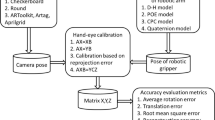Abstract
Accurate load sensing of a manipulator becomes increasingly important in performing various tasks involving contact with an environment. Most of the research has been focused on improving the hardware of a force/torque sensor. The torque sensors for a manipulator suffer from crosstalk, which is difficult to compensate for even with sophisticated calibration. This research proposed a novel calibration method composed of two steps. Through the primary calibration, the torque sensor output can be related to the joint torques. The secondary calibration, which is based on a virtual load, is conducted to compensate for the crosstalk of a torque sensor. The virtual load is obtained from the sensed joint torques and manipulator configuration. Using the proposed calibration method, the external load acting on the end-effector of a manipulator can be accurately measured even with relatively low-quality torque sensors. The experimental results showed that the error in the load sensing was significantly reduced by the proposed calibration method.
Similar content being viewed by others
References
Kim, Y. H., “Laboratory-level Telesurgery with industrial robots and haptics devices communicating via the internet,” Int. J. Precis. Eng. Manuf., Vol. 10, No. 2, pp. 25–29, 2009.
Kim, B. H., “Modeling and Analysis of Robotic Dual Soft-fingered Writing,” Int. J. Precis. Eng. Manuf., Vol. 10, No. 2, pp. 17–23, 2009.
Kang, C. G., “Performance Improvement of a 6-Axis Forcetorque Sensor via Novel Electronics and Cross-shaped Doublehole Structure,” Int. Journal of Control, Automation, and Systems, Vol. 3, No. 3, pp. 469–476, 2005.
Kim, G. S., “The design of a six-component force/moment sensor and evaluation of its uncertainty,” Measurement Science and Technology, Vol. 12, No. 9, pp. 1445–1455, 2001.
Shimano, B. E., “Kinematic design and force control of computer controlled manipulators,” Artificial Intelligence Lab., Stanford Univ., AI Memo No. 313, 1978.
Bicchi, A., “A Criterion for Optimal Design of Multiaxis Force Sensors,” Journal of Robotics and Autonomous Systems, Vol. 10, No. 4, pp. 269–286, 1992.
Voyles, Jr., R. M., Morrow, J. D. and Khosla, P. K., “Shape from motion approach to rapid and precise force/torque sensor calibration,” Proc. of Int. Mechanical Engineering Congress and Exposition, DSC-Vol. 57-1, pp. 67–73, 1995.
Ma, D., Hollerbach, J. M. and Xu, Y., “Gravity Based Autonomous Calibration for Robot Manipulators,” Proc. of Int. Conf. on Robotics and Automation, Vol. 4, pp. 2763–2768, 1994.
Kim, B. S., Yun, S. K. and Kang, S. C., “Development of a Joint Torque Sensor Fully Integrated with an Actuator,” Proc. of Int. Conf. on Control, Automation and Systems, pp. 1679–1683, 2005.
Taghirad, H. D., Helmy, A. and Belanger, P. R., “Intelligent Built-in Torque Sensor for Harmonic Drive Systems,” Proc. of IEEE Instrumentation and Measurement Technology Conference, pp. 969–974, 1997.
Kim, J. Y., Park, I. W., Lee, J., Kim, M. S., Cho, B. K. and Oh, J. H., “System Design and Dynamic Walking of Humanoid Robot KHR-2,” Proc. of IEEE Int. Conf. on Robotics and Automation, pp. 1443–1448, 2005.
Vischer, D. and Khatib, O., “Design and Development of High-Performance Torque-Controlled Joints,” IEEE Transactions on Robotics and Automation, Vol. 11, No. 4, pp. 537–544, 1995.
Aghili, F., Buehler, M. and Hohherbach, J. M., “Design of a Hollow Hexaform Torque Sensor for Robot Joints,” International Journal of Robotics Research, Vol. 20, No. 12, pp. 967–976, 2001.
Denavit, J. and Hartenberg, R. S., “A Kinematic Notation for Lower Pair Mechanisms Based on Matrices,” J. of Applied Mechanics, Vol. 22, pp. 215–221, 1955.
Author information
Authors and Affiliations
Corresponding author
Rights and permissions
About this article
Cite this article
Lee, SH., Kim, YL. & Song, JB. Torque sensor calibration using virtual load for a manipulator. Int. J. Precis. Eng. Manuf. 11, 219–225 (2010). https://doi.org/10.1007/s12541-010-0025-0
Received:
Accepted:
Published:
Issue Date:
DOI: https://doi.org/10.1007/s12541-010-0025-0




